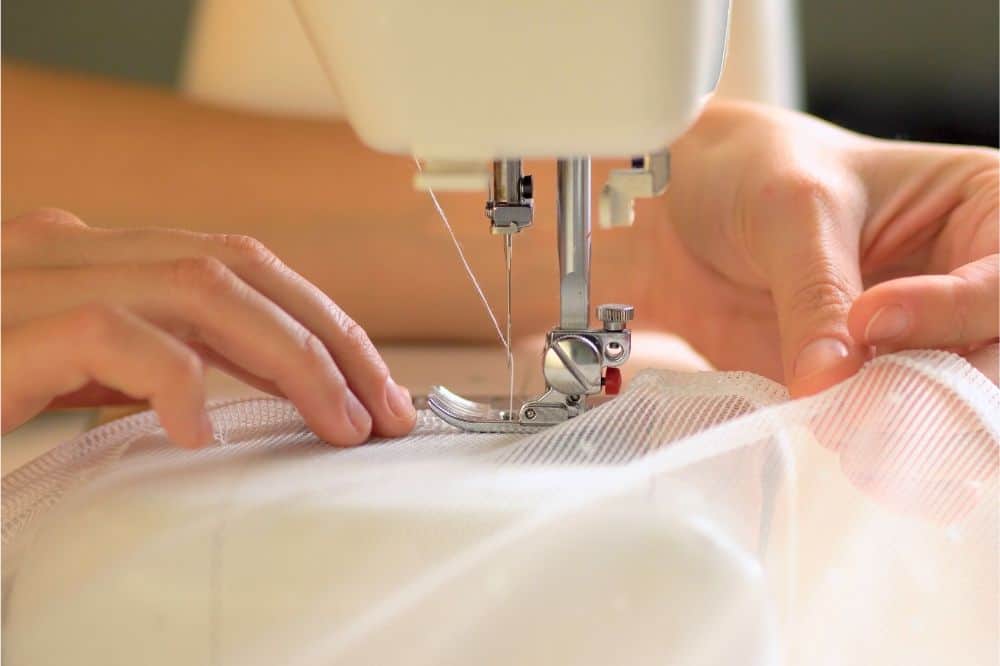There are several techniques you can make use of to finish your garment piece. A rolled hem is amongst them and can be used on light to medium weight fabrics. Unfortunately, it is not the best hemming technique for heavier fabrics like wool tweed, denim, polyester fleece, etc. Silks and sheers are the perfect material to use this technique on, as it gives a neat, perfect, and small turned finish to the hem.
There are three commonly known ways to sew a rolled hem that many seasoned seamstresses swear by. A rolled hem guarantees a clean finish to your garment, whether it is occasion wear or lingerie garments.
Ways To Sew a Rolled Hem
Rolled hems are meant for delicate fabrics, and produce a very small turned hem. To achieve the perfect rolled hem, you can either use a machine with a presser foot, a manual machine that does not use your foot, or simply by hand.
Using a Rolled Hem Foot
If you intend on buying a rolled hem foot, make sure you have done enough research to know the type of presser foot you need. Certain presser feet make straight stitch rolled hem feet, while others make zig-zag rolled hem feet.
Though the zig-zag rolled hem looks decorative, and many would love the hemming style, others may prefer the classic straight stitch. Therefore, be mindful of the rolled hem foot you are going to be purchasing. Many rolled hem feet that allow you to make zig-zag, shell, or scallop-like stitches offer straight stitches too, but that might not be the case the other way around.
It takes just a tiny amount of practice before you get the hang of making different types of stitches. It may come out to be a little more difficult than what you expected at the start, but once you get used to it, it gets easier.
How To Sew a Rolled Hem Without Foot
If you don’t have the patience you need to sew a rolled hem by hand or a foot presser, rolled hem without a foot is just the option for you. The pattern instructions for Cascade skirts and Tania Culottes are appropriate for sewing a rolled hem without foot. If the instructions are carefully followed, you will master sewing a rolled hem in no time, without much effort. You just have to devote a certain amount of care and attention to following the patterns.
How To Sew A Rolled Hem By Hand
It may be the most time-consuming rolled hemming technique, but the results are without a doubt worth it! The hems turn out to be naturally soft, without any visible stitches. You are going to be needing a lot of patience to bear with this technique as it takes time to sew and perfect the stitch.
The perfect rolled hems are delicate and neat. The neatness of a rolled hem that is sewn by hand is difficult to obtain with any machine. A rolled hem is done only on light fabrics; therefore, you need to be extra careful while sewing.
The first step is to make sure that your fabric is light, and that the edge you want to hem is at the top. It is important to begin by ensuring that your fabric is right-side-up before tackling the rolled hem.
Get your thread and needle ready for the hem work. The tricky part is measuring out the perfect length for your thread. The thread should be no more than the length from your wrist to your elbow.
Fold the edge of your fabric and start rolling the hem from right to left in between your fingers. The narrower the hem, the better the final result will be. To lay a good foundation, a minimum of three back stitches on top of one another is a good way of securing the thread without making a knot.
Create a narrow double fold in order to complete the second hem fold. A double fold can be created by making the first stitch at the very edge of the folded fabric, pulling the thread a little loose, and then passing the thread over the folded edge. Next, make a horizontal stitch and you will be able to notice a zig-zag shape.
Repeat the same process once more of pushing the needle across the hem fold, bringing it back to the front, and taking the horizontal stitch from the material, and pulling the thread a little loose through the fabric of the garment.
Continue doing so until you start noticing a zig-zag pattern following through. After continuing the same process three times, pull on the thread tightly, and you’ll notice the hem folding over on itself, creating a perfect rolled hem.
You can press down on the hem with your thumb and crease the fold to secure your edge.
Continue with the process until you finally reach the end. Finish your rolled hem by working three back stitches on top of the other without making a knot.
Conclusion
Rolled hems are delicate and give an elegant finish to your light fabric. People mainly use either of the three ways to achieve a perfectly finished rolled hem. They either use a machine with a presser foot, a machine without a presser foot, or without a machine at all.
Working out a rolled hem by hand is amongst the most time-consuming techniques, yet also the most efficient. The neatness of a hand is difficult to be achieved by a machine. A machine-made hem is easier to detect due to the obvious difference in technique.
The zig-zag stitch is amongst the most common stitches used for a rolled hem, but it is by no means the only choice. Slip stitch, herringbone stitch, and slant hemming stitch are other stitches that can be used to achieve a rolled hem with different sewing techniques. You can experiment with various techniques to find what suits you best, and what will give you the best results.


